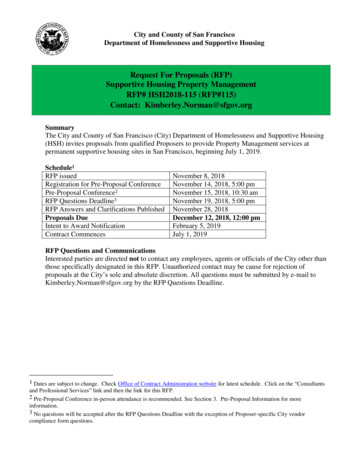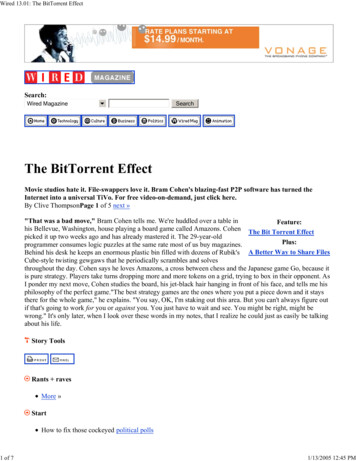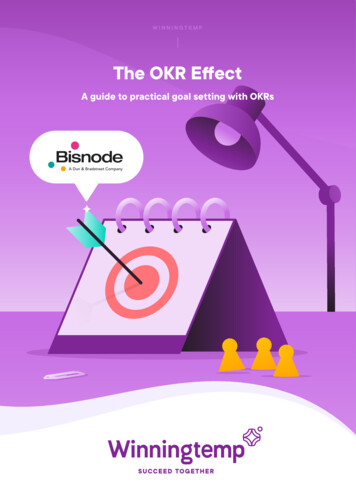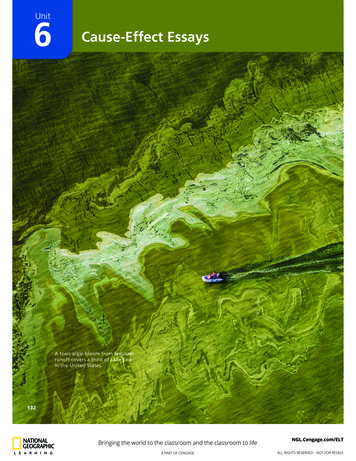
Transcription
The billionaireeffectNew visionariesand the ChineseCenturyNovember 2019Issue 6Billionaires insights 2019Billionaires insights 2018Billionaire-controlled companies outperform Transforming the business of global philanthropyFrom long-term vision to smart risk-taking Five strong years close with a dipab
A few words about our researchThis is the sixth of our reports on billionaire wealth, continuing our investigation into this historic era of wealth generation. We have expanded the scope of our research to include an examination of the performance of billionaire-controlledcompanies and a survey of UBS advisors’ views on their billionaire clients’ current activities. Our research universe covers2,101 billionaires from 43 countries in the Americas, EMEA and APAC, looking back over more than two decades. Ourdatabase includes the 43 largest billionaire markets, which account for around 98% of global billionaire wealth. Further,we’ve conducted over 25 interviews with billionaire advisors and further face-to-face interviews with more than 30 billionaires. UBS and PwC advise a large number of the world’s wealthy, and have unique insights into their changing fortunesand needs. (For more information see our research methodology on page 30.)
Contents5Foreword6Executive summary10Section 1:The billionaire effect: driving outperformance17Section 2:Transforming the business of global philanthropy20Section 3:Five strong years close with a dip28Section 4:Looking ahead
The billionaire effectThe past 30 to 40 years stand out as a time of exceptional innovation in business. The pace of economicchange has been faster than at any other time in history. A relatively small number of entrepreneurs havebeen the agents of that change, applying new technologies and business models.Now in its fifth year, this report analyzes how these entrepreneurs’ businesses have excelled. Long-term vision, smart risktaking, business focus and determination have resulted in businesses that have tended to outperform others financially.That is the “billionaire effect” and it continues to have a huge influence, especially in technology industries of the futureand China’s fast-developing economy. As this report shows for the first time, you see it in the long-term outperformanceof billionaire businesses. And a small but significant number of billionaires are working together to break new ground inphilanthropy.There was a dip in wealth in 2018, but in our view this should be set within the context of the broader trend of stronggrowth. Billionaire wealth dropped 4.3% globally, after five years when it grew by 34.5%.* As the center of economic activity shifts towards Asia, the region’s entrepreneurs are playing a strong role. There will be many more winners and losersin the years to come.In this year’s report we have tried to break new ground in our own way. Our study of the performance of billionaire companies is unprecedented and quantifies their strong results. We also surveyed over 100 UBS advisors – all of whom workclosely with billionaire clients – to gauge billionaire sentiment in more depth. Taken together with a comprehensive set ofclient interviews, this research reveals entrepreneurs reacting pragmatically to prevailing uncertainty in the economy andgeopolitics.As we look ahead to the next five years, it is difficult to predict the future. Our research tells us that leading entrepreneursare primed for a more difficult environment. But what will remain constant is the billionaire effect – the ability to transform entire industries, to create large numbers of well-paid jobs, and to rally the world to find cures for diseases such asmalaria.Josef StadlerGroup Managing DirectorHead Ultra High Net WorthUBS Global Wealth ManagementJohn MathewsGroup Managing DirectorHead Ultra High Net Worth AmericasUBS Global Wealth ManagementRavi RajuGroup Managing DirectorHead Ultra High Net Worth Asia PacificUBS Global Wealth ManagementDr. Marcel TschanzPartner and Swiss HeadWealth Management,PwC SwitzerlandThomas J. HollyPartnerUS Asset & Wealth ManagementSector Leader, PwC USJulia LeongPartnerPrivate Banking LeaderPwC Singapore*Source: UBS/PwC Billionaires database.UBS/PwC Billionaires insights 2019 5
Executive summaryBillionaire-controlled companiesoutperformFrom long-term vision to smartrisk-takingSmart risk-takingBusiness focusMarket return17.8%Over the 15 years to the end of 2018, billionaire-controlledcompanies listed on the equity market returned 17.8%versus the 9.1% of the MSCI ACWI, almost twice theannualized average performance of the market.Their companies are also more profitable, earning anaverage return on equity of 16.6% over the last 10 years,compared to the 11.3% of the MSCI ACWI.**Source: UBS/PwC Billionaires database.6 UBS/PwC Billionaires insights 2019DeterminationWe call the tendency of billionaire-controlled companies tooutperform the billionaire effect.Why does it exist? In our view, billionaires have three distinct personality traits that benefit businesses – smart risktaking, business focus, and determination.Additionally, like family businesses more generally, billionaires’ enterprises tend to have a long-term strategy.
Transforming the business of globalphilanthropyFive strong years close with a dip-4.3%Drop in wealth byFresh from creating pioneering businesses, a small butgrowing number of billionaires have become even moreambitious: they want to make the world a better place.They are using the same characteristics that drove theirbusiness success to address the UN’s 17 SustainableDevelopment Goals (SDGs).“Impact” has become the key word for these leadingentrepreneurs, who are seeking new ways to engineerfar-reaching change.Over the five years to the end of 2018, billionaire wealthgrew by more than a third (34.5%), reaching a total ofUSD 8.5 trillion, USD 2.2 trillion higher than five yearsearlier.In the same period, 589 individuals became billionaires,increasing the population by 38.9% to 2,101.But in 2018 billionaire wealth dropped by 4.3%, or USD388 billion, in the face of a strong US dollar, trade friction,fears of lower economic growth, and financial marketvolatility.**Source: UBS/PwC Billionaires database.UBS/PwC Billionaires insights 2019 7
The Athena factor revisitedThe rise of tech’s titans3.4%GrowthIncrease46%Women became billionaires at a faster rate than men overthe five years to the end of 2018.Tech entrepreneurs are injecting dynamism into the globaleconomy, beyond their own sector.The number of female billionaires increased by almost half(46%) in the period, rising from 160 to 233. Meanwhile,the number of men expanded by 39%.It is no accident that technology is the only industry wherebillionaire wealth increased in 2018, rising 3.4% to USD1.3 trillion. Their net wealth has almost doubled over thelast five years, growing 91.4%. Software, internet, andelectronic equipment entrepreneurs have built powerfulbusinesses over the past 30 years.We originally identified what we call the ”Athena factor“in 2015, noting that between 1995 and 2014 the numberof female billionaires grew by a factor of 6.6, while thenumber of men increased by a smaller factor of 5.2.**Source: UBS/PwC Billionaires database.8 UBS/PwC Billionaires insights 2019However, pioneers driving the future of subsectors suchas e-commerce, fintech, ride-hailing, and data systems areemerging fast.*
China’s volatility202.6%Growth12.3%Net worth correctedChina’s entrepreneurs have become the world’s secondlargest billionaire group over the past five years, overtakingRussia’s. Wealth almost tripled, growing by 202.6% toreach USD 982.4 billion.But in 2018, Chinese billionaires’ net worth declined by12.3%. The number of Chinese billionaires fell by 48 to325.Beyond the headline there were bigger swings in billionairenet worth. In fact, 103 people’s wealth dipped below abillion dollars, while 56 made the threshold.**Source: UBS/PwC Billionaires database.UBS/PwC Billionaires insights 2019 9
Section 1:The billionaire effect:driving outperformanceIn the story of commercial endeavor, the 30–40 years sincethe 1980s stand out as an entrepreneurial age. Starting inthe US in the 1980s and then moving to Asia from 2000, asmall number of entrepreneurs have applied new technologies and business models to change entire industries. Thepace of economic change has been faster than at any othertime in history.These entrepreneurs have excelled at creating and steering businesses that outperform. Along the way they havebecome billionaires.It would seem intuitive that billionaires’ companies shouldcontinue to outperform after they have reached this levelof wealth. Yet it’s by no means a given: after all, past performance is no guarantee of future success. How much isluck? How much is skill? At what point do entrepreneurslose their drive?But our analysis confirms that, on average, billionaires’success does continue – in both public equity markets andprivate markets. In fact, billionaire-controlled businessesoutperform by a surprisingly large margin.We call this the billionaire effect.
Delivering twice the market returnOver the 15 years to the end of 2018, billionaire-controlledcompanies listed on the equity markets returned almosttwice the average market performance.1 Their annualizedperformance was 17.8% versus 9.1% for the MSCI ACWorld Index.2Self-made billionaires‘ companies outperformed their multigenerational peers by an average of just 1.4% annuallyover the 15 years, with the rate of their outperformanceaccelerating from 2011. When control remains in the family,outperformance seems to last.While the billionaire effect was strongest in the US, it wasclosely followed by APAC, where the Chinese economyin particular is continually reinventing itself, letting somebusinesses expand exponentially while others falter. Consumers willingly embrace fresh concepts. New technologyand business models quickly succeed, supplanting theirpredecessors. Europe has lagged behind slightly, yet billionaire-controlled companies still outperformed significantly.Billionaire-controlled public companies’ index vs. MSCI ACWI (2003–2018)1,6001,5001,4001,3001,200 17.8%1,1001,000Index Value900800700600500400300 9.1%2001000Annualized average return31 Dec 0331 Dec 0531 Dec 07Billionaire-controlled public companies131 Dec 0931 Dec 1131 Dec 1331 Dec 1531 Dec 1731 Dec 19MSCI ACWIControl is defined as owning 20% or more of the company and/or 30% ormore of the voting rights. More subjectively, we have also included companieswhere the billionaire may not have this percent of equity or votes but evidentlysteers the business.2Equally-weighted billionaire index taking into consideration billionaire-controlledcompanies of 2003, 2008 and 2013, see explanation of section 1 researchmethodology on page 30.UBS/PwC Billionaires insights 2019 11
Consistently more profitableFurthermore, looking at the companies controlled by billionaires in 2018 – whether public or private – the profitability of billionaire-controlled companies far exceeds theaverage for the MSCI AC World Index. Overall, public andprivate billionaire companies’ average return on equity(ROE) was 16.6% over the 10 years to the end of 2018.The MSCI AC World Index averaged 11.3%. During thestudy period, the ROE of all companies varied as interestrates fluctuated, causing the cost of capital to rise and fall.315.3%13.0%12.1%17.1%16.9%13.8%10.2%15.2%Avg. PHBC ROE17.1%Avg. PLBC 8%1016.7%10.6%8.3%12Avg. MSCIACWI 13.3%Average Return on Equity in %2222.1%22.3%Profitability performance – public vs. private companies (2009–2018)86420200920102011Publicly listed (PL) billionaire-controlled (BC)201220132014Privately held (PH) billionaire-controlled (BC)Profitability is highest in the consumer and retail, technology, and financial services sectors. By contrast, companiesin entertainment and media, materials, and utilities havethe lowest ROEs, perhaps unsurprisingly as media companies have struggled against digital competition, materialsbusinesses have experienced headwinds from depressedcommodity prices, and utilities are facing stiffer competition from new renewable energy sources.201620172018MSCI ACWIBut a small subset of billionaire businesses target growthin capital value rather than profitability. In a similar way toa number of loss-making tech businesses, some of whichhave recently launched IPOs, they are focusing on maximizing their sale price. Some 27 of the 535 billionaire companies we analyzed were making a loss – a third of them(nine) from the tech sector.43412 UBS/PwC Billionaires insights 20192015See explanation of section 1 research methodology on page 30.535 is the total number of companies for which data was available over thestudy period (and after allowing for outliers) for the ROE analysis.
Champions of IPOsEven as they cross from private to public ownership,billionaire businesses continue to be more profitable thannon-billionaire-controlled ones. Our analysis shows billionaires control 102 businesses that have publicly listedin the past 10 years. In the three years leading up to IPO,these businesses had an average ROE of 35.4%.After listing, the ROE naturally declined substantially asthe creation of new equity diluted profitability. AverageROE dropped to 17.3%, but then steadily recovered in thefollowing years. For comparison, analysis of the broaderIPO universe over the same 10 years shows average ROEdropping to 14.8% after IPO and then declining still furtherin the following years.536.1%38.5%Pre- and post-IPO performance analysisBillionaire-controlled companies19.5%17.7%8.7%8.9%16.7%10.2%Year 3Year 4Year 5Year 6Non-billionaire controlled companiesWith billionaire-controlled businesses performing so strongly, it is little wonder that most billionaires choose to keepcontrol. Almost all of the 2,101 billionaires on our databasestill hold interests in businesses. Some 1,936 have holdings518.2%10.8%Year 29.3%Year 19.9%31.6%IPO Eventin companies – in 65% of cases they have controllingstakes. Their holdings in public and private businesses areroughly equal in number.Our database includes over 9,000 companies that listed through an IPObetween 2008 and 2018.UBS/PwC Billionaires insights 2019 13
Billionaires have an obsessivebusiness focus, constantly scanning theworld for new opportunities.From long-term vision to smart risk-takingWhy is there a billionaire effect? In our view, billionaires’businesses thrive on the three distinct personality traitsthat we identified in our first billionaire report.6 These areappetite for smart risk-taking, business focus, and determination.When it comes to taking risk, billionaire entrepreneurshave a very optimistic attitude, focusing on risks theyunderstand and finding smart ways to reduce them. Theyhave an obsessive business focus, constantly scanning theworld for new opportunities. And they are highly resilient,undeterred by failures and roadblocks.But like family businesses more generally, billionaires’ enterprises tend to pursue a long-term strategy that benefitsfrom an exceptional alignment between performance andmanagement incentives, whether the founder remainsin control or a CEO from outside the family is hired. Thatleads to laser-focused research and development, concentrated on the products most likely to create future value, aswell as continual investment in the workforce.“Our CEO is not motivated by salary nor bonus. Insteadhe has full alignment with the best interests of the family,the stakeholders, and the company’s values,” explains theoffice of a Hong Kong real estate billionaire.The result? Billionaire businesses often lead the way. Theyunderstand their customers and innovate relentlessly.In the words of a Swedish tech entrepreneur: “We generateinnovation to drive growth continuously. Our long-termplanning, the involvement of stakeholders, and a customercentric approach are at the core of our decision-makingprocess.”All our analysis leads to one conclusion: the outperformance we call the “billionaire effect” depends on theentrepreneur keeping control, irrespective of whether thebusiness is public or private.6“Master architects of great wealth and lasting legacies”. UBC/PwC. 2015.14 UBS/PwC Billionaires insights 2019
Businessfocus
Impact entrepreneursseek new ways toengineer environmentaland social change.
Section 2:Transforming the businessof global philanthropyHaving created pioneering businesses, a small but growingnumber of billionaire entrepreneurs have now becomeeven more ambitious: they want to make the world abetter place by making a significant positive social andenvironmental impact. The same characteristics that drovetheir business success are being used to address the UN’s17 Sustainable Development Goals (SDGs).7These entrepreneurs are seeking new ways to engineerfar-reaching environmental and social change. For themthe key word is “impact,” which describes the broadereffect of a program or investment. For example, studieshave shown that if you reduce infant mortality, the macroeconomic impact of this at scale is a rise in economicgrowth and well-being.8 Similarly, improved education hasthe same effect.Across the world, billionaires now possess huge privatewealth and only a small portion of that is dedicated toachieving impact through philanthropy or social finance.But, undeniably, growing numbers of billionaires are applying both their talents and their treasure to achieving impact– in some cases with outstanding results.Why is this exciting? Because after 30 years of success,ultrawealthy entrepreneurs have accumulated considerableassets; they have proven problem-solving and organizationalskills; they are in positions of influence. Further, they canrisk new approaches that might only see results over thelong term.These impact entrepreneurs are strategic, innovative, andcollaborative. They aim to be catalysts for change, by developing models that can spark systemic shifts if followedby others.New collaborators and catalysts for changeTraditional grant giving is evolving into strategic philanthropy. It has quietly been notching up big successes, especiallyin curing global diseases. The Bill & Melinda Gates Foundation, reputed to be the world’s largest foundation with anendowment of USD 46.8 billion,9 is a frontrunner. Since itsestablishment in 2000, the foundation has contributed tothe virtual eradication of polio globally, and of meningitisA in sub-Saharan Africa. Currently, its goal for malaria isnothing short of “a world free of malaria.” The foundation‘s goal is to be “catalytic in reducing the burden ofmalaria and accelerating progress toward eradication of thedisease.”10 Working with others such as the World HealthOrganization and other donors from around the world, it isfocusing on the areas where it can have the most impact interms of saving lives, using data to help refine its activities.Historically, philanthropists acted alone. Think of the golden age of industrialist philanthropy, shaped by Carnegie,Ford, and Rockefeller. Even now, charitable foundationsgenerally (not just billionaire-related) operate their ownprograms and activities.11 But that is changing. Billionairephilanthropists in particular are realizing that the bestresults are achieved through collaboration – not only withother billionaires, but also with the NGOs, charities, andgovernmental organizations that have the expertise andaccess needed to drive change.A domestic US example of collaboration is the San DiegoTrafficking Prevention Collective. Two dozen philanthropists, the UBS Optimus Foundation, school districts,governmental officials, and local organizations have cometogether to raise awareness of human trafficking in theCalifornian county, which ranks in the top 13 areas in theUS for human trafficking.12Early successes show what can be achieved as this trendcontinues.91078Estimated annual funding gap stands at USD 5–7 trillion.Gates Foundation annual letter 2014.1112Bill & Melinda Gates Foundation factsheet.Bill & Melinda Gates Foundation website.Global Philanthropy Report. Harvard Kennedy School, supported by UBS.UBS Optimus Foundation has helped to fund this project.UBS/PwC Billionaires insights 2019 17
There are also growing numbers of foundations across theworld that are taking a collaborative and catalytic approach.The Children’s Investment Fund Foundation (CIFF), backedby a London hedge fund, is an example. It works with arange of partners to transform the lives of children andadolescents in developing countries, aiming to have a catalytic role and effect change at scale.But this development is not limited to US or Europeanfoundations. Take the Yidan Prize, established in 2016 byDr. Yidan Chen, a founder of Tencent Holdings. While notan example of collaboration, the prize aims to be a catalystin making education fit for the challenges of the future.It has the bold mission of creating a better world througheducation. Giving out awards of HKD 60 million (aboutUSD 7.8 million) annually, the prize rewards two things:outstanding research into education, and innovative ideasto tackle challenges in education.Some billionaire philanthropists now believe that instead ofreinventing the wheel by building their own organizations,it’s better to partner with specialist NGOs and charities,rewarding them for delivering outcomes such as higherrates of literacy. Charities are evolving accordingly to remain competitive.Architects of impactBillionaires are increasingly impartial about how they createimpact. They may have different pools of capital, some forgrants and others set aside to make a return from sustainable investments.Breakthrough Energy Ventures shows how a network of 21well-known billionaires – ranging from Richard Branson toJeff Bezos and from Jack Ma to Prince Al-Waleed bin Talal– is seeking to develop new clean energy technologies. Thegoal? To provide scalable and profitable tools that enablea carbonless future, achieving environmental impact whilealso making a competitive financial return. An exampleof a Breakthrough Energy Ventures investment is FervoEnergy, a start-up seeking to develop geothermal energy asa source of clean electricity.On the frontier between philanthropy and investing aredevelopment impact bonds13, an evolving type of socialfinance. These bonds are backed by results-based contractsin which investors can realize a financial return tied tosocial impact, and outcome funders only pay for successfulresults.While these impact bonds have raised only a small amountof money from billionaires so far, there is growing interest(see India’s children box). The International Committee ofthe Red Cross is a pioneer of impact bonds, launching thefirst humanitarian impact bond in 2017. This inauguralbond aims to transform the financing of vital services provided to citizens disabled in conflict in Nigeria, Mali, andthe Democratic Republic of Congo.Illustrating his commitment to making an impact, a Dutchentrepreneur from the consumer and retail sector told us:“Society expects me to be a philanthropist with my money,but the motivation for my philanthropic activities comesfrom a sense of purpose and changing the status quo.”Three key ingredientsThe future success of entrepreneurs in achieving the broadsocial and environmental impact that they seek may depend on:I. New approaches that aim to create catalysts for changeand to deliver positive impact on a significant scale.II. Consistent, verifiable outcome/impact targets that showwhat is being achieved, encouraging more widespreadparticipation among not just the wealthiest philanthropists but also a wide range of pension funds, foundations, etc.III. Widespread advocacy of the merits of collaborationthat brings together teams of different stakeholdersand leads to support for this “impact-first” approachover the traditional “outputs-based” official aid models.1318 UBS/PwC Billionaires insights 2019Development impact bonds are not financial products
India‘s children: transforming prospectsIn India’s Rajasthan, financial innovation has improvededucation for thousands of girls across hundreds ofschools and villages, while showing the effectivenessof impact bonds.Over the past three years to the end of 2018, theEducate Girls Development Impact Bond has liftedgirls’ enrollment in schools and learning. It led to araft of innovations, including a better child-centriccurriculum and a shift in mindset towards girls’education, supporting and prioritizing the integrationof girls into the education system.The Development Impact Bond‘s success dependedon strong partnerships. Educate Girls was the NGOcarrying out the program. UBS Optimus Foundationprovided the up-front risk capital, and The Children’sInvestment Fund Foundation paid for the outcomeonce the program’s targets were reached, including abonus for Educate Girls.Following this first success, the Quality EducationIndia Development Impact Bond was launched in2018 to improve literacy and numeracy for 300,000children. It is supported by the British Asian Trust,Michael & Susan Dell Foundation, UBS OptimusFoundation, Tata Trusts, and The Mittal Foundation.14The shape of billionaire philanthropyOur research suggests that a high number of billionaires are involved in philanthropy, although thesize of their contribution is difficult to define. Of thewealthiest 500 billionaires, more than 400 publiclyengage in philanthropy to varying degrees.There are different preferences for giving regionally.While EMEA billionaires give mainly (61%) to international projects, Asian billionaires mostly (70%)favor projects closer to home. In the US, giving is split50/50 between international and domestic.Our analysis shows that education is the most popular recipient of billionaire philanthropy, favored by37% of billionaire donors and especially popular inAsia (although the greatest sum of dollars may bedevoted to healthcare, as individual projects requiresignificant funding). Healthcare is the second mostpopular recipient of philanthropy.Types of billionaire philanthropy activitiesEducation9%9%37%10%HealthCulture and artsSciencePoverty14%21%14There are now nine development impact bonds and 156 social impactbonds. Source: Brookings Institution, August 2019.EnvironmentAn area that is under-funded but attracting interestfrom some of the most innovative philanthropists isthe environment and climate change. For example,Salesforce founder Marc Benioff has established theBenioff Ocean Initiative, devoted to ocean science.Meanwhile, Michael Bloomberg has launched Beyond Carbon, the largest coordinated campaign totackle climate change in the United States.UBS/PwC Billionaires insights 2019 19
Section 3:Five strong years close with a dipOver the past five years to the end of 2018 – the periodcovered by the UBS/PwC Billionaire reports – the “billionaireeffect” has been especially evident. Just a small numberof enterprising businessmen and women engineered hugechange in Asia’s dynamic economies, especially China, andin the US tech sector based mainly in California.As they have done so, and as asset prices generally haverisen, so billionaire wealth has increased. The aggregatewealth of billionaires ended 2018 over a third (34.5%), orUSD 2.2 trillion, higher than five years earlier.15 Five hundred and eighty-nine individuals became billionaires for thefirst time, increasing the billionaire population by 38.9% to2,101.Fifteen years of asset growth (in USDtrn)1,10012 trn 166%1,00011 trn10 trn 374%9009 trnMSCI ACWI Index8008 trn 27%7006007 trn 34%6 trn5005 trn4004 trn3003 trn2002 trn1001 trn2003APAC2008EMEA2013Americas2018MSCI ACWI* MSCI ACWI (gross) captures large- and mid-cap representation across 23 Developed Markets (DM) and 24 Emerging Markets (EM) countriesHowever, in 2018 wealth creation paused as equity markets around the world suffered their worst correction sincethe 2008 financial crisis. (The last time billionaire wealthdeclined was in 2015.)Billionaires’ net worth fell by 4.3% year-on-year, or USD388 billion, to USD 8.5 trillion. This was partly due to thetranslation effect of a strong dollar, as well as volatile financial markets and less buoyant economic conditions.1615Billionaire wealth outperformance of the MSCI ACWI index partly arisesfrom the fact that a greater proportion of billionaires are based in developedmarkets, which outperformed developing markets over the period.20 UBS/PwC Billionaires insights 2019The number of billionaires fell by 57, or 2.6%, with especially sharp falls in wealth in China and India.2018 was a challenging year as the geopolitics of US/Chinatrade friction intensified, leading to fears of lower economic growth. Billionaires slightly underperformed the MSCIACWI Index, which fell a smaller 2.4%.171617The dollar climbed 4.3% during the year, according to the WSJ Dollar Index,which measures the US currency’s performance against a basket of16 currencies.Measured from February 2018 to February 2019.
Wealth creationpaused in 2018
China’s entrepreneurs havequickly risen to become theworld’s second largest billionairegroup in five years.Billionaire wealth dips (in adeMultigenerationalBillionaire wealth fell most sharply in the APAC region, withChina particularly affected. APAC billionaire wealth corrected by 8.0%. The region was affected by slowing growth inChina and rising US interest rates. Wealth in APAC ended2018 at USD 2.5 trillion, down USD 217.6 billion. The netnumber of billionaires in the region fell by 7.4%, or 60,to 754. But that number masked considerable churn, as169 people fell off the billionaire list and 110 new entrantsemerged.18Showing that the tough conditions were not limited toChina and nearby economies, the representative of an Indian consumer a
Self-made billionaires‘ companies outperformed their multi- generational peers by an average of just 1.4% annually over the 15 years, with the rate of their outperformance accelerating from 2011. When control remains in the family, outperformance seems to last. While the bi










